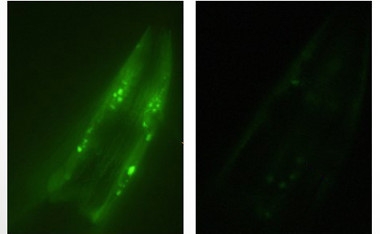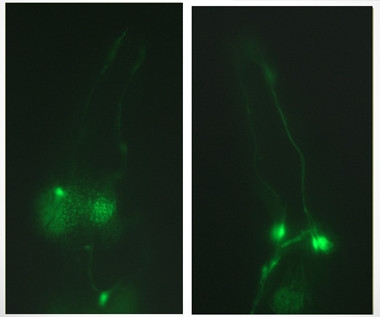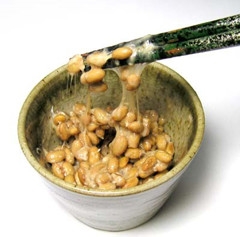Do Immune Responses Promote, or Prevent, Parkinson’s Disease?
Quick Links
Researchers keep turning up unexpected links between Parkinson’s disease and the immune system. At the first Advances in Alzheimer’s and Parkinson’s Therapies Focus Meeting (AAT-AD/PD), March 15–18 in Turin, Italy, Michael Schlossmacher of the Ottawa Hospital Research Institute, Canada, reported that the PD-linked gene LRRK2 helps mice fight bacterial and viral infections. Together with previous findings that animals release α-synuclein in response to infection, the data support the idea that microbial exposure could play a role in neurodegenerative disease. And if bad bacteria can hasten PD, could good bacteria delay it? A hint in this direction came from Roberto Grau of Rosario National University, Argentina, who reported that feeding probiotic bacteria to worms prevented α-synuclein accumulation and neurodegeneration. The bacteria turned on longevity genes, which may control α-synuclein folding and degradation, Grau suggested. He is about to test his idea in an upcoming PD trial.
- A PD risk gene supercharges the immune response to fight off infections.
- Beneficial bacteria slow the accumulation of α-synuclein in mutant worms.
- Together, the data suggest that immune responses may modulate PD risk.
If confirmed, the studies imply that microorganisms, and the immune response to them, may modify PD risk, for good or ill. “We think that environmental triggers such as microorganisms interact with the genetic makeup of the host organism to initiate inflammatory responses, and those responses determine the outcome of the illness,” Schlossmacher told Alzforum. His team recently drew attention to this complex disease model of PD pathogenesis and is testing this idea in animal and human studies (Schlossmacher et al., 2017).
The idea that systemic infections might be at the root of some cases of PD has been gaining some ground in the last decade (July 2011 news series). Researchers recently reported that gut infections stimulate the release and aggregation of α-synuclein (Oct 2016 news; Jul 2017 news). The protein is expressed in the peripheral and central nervous system neurons, as well as in red blood cells and platelets (Barbour et al., 2008; Scherzer et al., 2008). In mice, the normal gut microbiome accelerates α-synuclein pathology, while in people, the composition of gut microflora changes early in the disease (Dec 2016 news; Apr 2017 news).

B. Subtilis Squelch Synuclein.
PD model worms (left) accumulate α-synuclein deposits (green), but not when fed probiotic bacteria (right). [Courtesy of Roberto Grau.]
Why does the body pump out α-synuclein in response to an infection? Last year, Schlossmacher and colleagues reported that the protein helped mice survive a virulent immune challenge, with α-synuclein knockouts succumbing sooner to a deadly virus (May 2017 news). Others have similar findings (Beatman et al., 2015). In Turin, Schlossmacher added new data, proposing a comparable immune modulatory role for LRRK2. This large multifunctional protein is highly expressed in microglia, monocytes, and adaptive immune cells, in addition to its expression in neurons and glia.
To plumb its role in infection, the researchers infected newborn LRRK2 knockout mice with reovirus T3D (Gauvin et al., 2013), and adult knockouts with salmonella bacteria. In both paradigms, the knockouts had evidence of more disease than wild-type, amassing about double the viral or bacterial burden. Female mice lacking LRRK2 were more susceptible to infection than males. Intriguingly, the pathological outcomes of female LRRK2 heterozygotes mirrored those of male knockouts, while male heterozygotes were more likely to be unaffected, responding to infection like wild-type mice. This work is currently in revision (Shutinoski B, Hakimi M, et al.).
PD-linked LRRK2 risk alleles are not knockouts, however. They are mostly gain-of-function variants that increase the protein’s kinase activity. What do those do in response to infection? Schlossmacher and colleagues tested mice that expressed the main PD risk variant, G2019S. In contrast to knockouts, they dealt with infections handily, keeping their viral or bacterial load low. Female mice survived bacterial sepsis better than males but succumbed sooner to a viral brain infection, though the number of mice examined thus far was small.
The G2019S variant is known to boost myeloid cell recruitment, and a different LRRK2 variant is a known risk factor for an excessive inflammatory response in people with leprosy caused by Mycobacterium leprae (Fava et al., 2016). Schlossmacher speculated that G2019S may augment inflammation, which helps the body fight off a virulent infection but could possibly harm the brain. If so, G2019S’s efficacy against infections may explain why this variant has survived in humans during evolution.
If independently confirmed, LRRK2 would be the first PD gene shown to have a strong gender effect in animal studies. The reason why is unclear, but the sex difference mirrors findings in people. In the Ashkenazi Jewish population, women carrying a G2019S variant are more likely than male carriers to develop PD, and their symptoms appear five years earlier on average (Cilia et al., 2014; Marder et al., 2015). This flips the normal gender effect in PD, where men are typically more susceptible.
In future work, Schlossmacher is investigating whether his LRRK2 findings relate to PD. He believes the protein may influence how the body mobilizes α-synuclein in response to an infection. “We think LRRK2 is the horse, and α-synuclein the buggy; where the buggy goes depends on which way the horse pulls,” he told Alzforum. This raises a question for ongoing trials of α-synuclein antibodies, Schlossmacher noted. If the protein helps defend the body against infection, lowering it too much could leave people more vulnerable. “Trialists should monitor patients for signs of infection,” he suggested.

Neuron Protection?
In PD model worms fed the standard diet of E. coli (left), dopaminergic neurons (green) degenerate; neurons stay healthy when the worms eat probiotics (right). [Courtesy of Roberto Grau.]
Working in Rosario, Grau focused on good bacteria instead of bad. He previously reported that the probiotic Bacillus subtilis delayed aging in the roundworm C. elegans by reducing insulin signaling (Donato et al., 2017). Because aging is a risk factor for PD, he wondered if the probiotic could protect against it. He used two worm models, one that overexpressed human α-synuclein, and another that expressed a risk variant in the parkin gene. These worms develop several phenotypes mimicking PD, including clumsy movement, constipation, and impairment in dopamine-dependent behaviors such as reproduction and avoiding danger.
When the mutant worms were raised on media containing Bacillus subtilis, however, nearly all these behaviors reverted to wild-type levels. The probiotic suppressed accumulation of α-synuclein into Lewy bodies by 75 percent, and prevented the degeneration of dopaminergic neurons (see images above). The worms lived as long as wild-types. The data suggest that probiotics could possibly prevent the development of PD pathology, Grau said.
The protective effect of Bacillus subtilis depended on its ability to form a biofilm, a slimy sheet of cells surrounded by an extracellular matrix. When the researchers used a mutant strain without that ability, few benefits accrued to the worms. Bacillus lives as a biofilm in the gut, and this organization allows the cells to communicate more efficiently among themselves and with the host, Grau explained.
In his previous study, he found that Bacillus biofilms dialed down insulin-signaling genes such as DAF-2 in the host. This suppression leads to the induction of protective genes, including FOXO and heat shock factor 1. HSF1 in turn mediates the response to cellular stress, and Grau believes it may turn on molecular chaperones that assist in the degradation of α-synuclein.
Grau plans to treat PD patients with the Bacillus subtilis strain DG101, along with their normal medications, to see if the probiotic might improve health, lower symptoms, or extend lifespan. This strain robustly induces FOXO and HSF-1, he noted. The trial is expected to start later this year. He plans to enroll more than 100 people in Argentina who are being treated for PD at private hospitals and follow them for six to 12 months.
In the Alzheimer’s field, treatments that target the aggregation of pathogenic proteins have not worked in symptomatic populations, possibly due to the long prodrome of the disease. This has fueled a push toward preventative trials.

Natto, Anyone?
This Japanese breakfast food of fermented soybeans is made with B. subtilis. [Courtesy of Wikimedia.]
Some people around the world already consume B. subtilis. For example, a Japanese breakfast food called natto is made by fermenting soybeans using the probiotic. The Japanese credit consumption of this food as one reason for their longevity. Grau told Alzforum that natto helped inspire his studies of B. subtilis’ health benefits.
The strain that makes natto produces the protease nattokinase, which degrades amyloid in mice and promotes non-amyloidogenic processing of Aβ (Hsu et al., 2009; Fadl et al., 2013). It is unclear if the food affects PD or Alzheimer’s risk. The incidence of Parkinson’s disease in Japan is somewhat lower than in most Western countries (Muangpaisan et al., 2009).
Schlossmacher called Grau’s work elegant, with fascinating implications. He noted that probiotics might trigger shifts in the relative abundance of other species in the gut microbiome, leading to changes throughout the intestine. In theory, such microbiome changes could also help prevent PD by keeping the α-synuclein response to infection in check, he said. Signs of ongoing α-synuclein aggregation occur in healthy people in the GI tract, notably in the appendix (Gray et al., 2013), and chronic constipation is associated with PD risk. Gut motility, which is influenced in part by the GI tract’s microbiome constituents, could thus be a modifiable risk factor, Schlossmacher argues.—Madolyn Bowman Rogers
References
Series Citations
News Citations
- Could Bacterial Amyloid Trigger Parkinson’s Pathology?
- Put ’Em Up: Does α-Synuclein Help Fight Microbes in the Gut?
- Do Microbes in the Gut Trigger Parkinson’s Disease?
- Rumblings of Parkinson’s: Gut Microbiome Shifts in Early Stage of Disease
- Olfactory System Model Explores Antimicrobial Role for α-Synuclein
Paper Citations
- Schlossmacher MG, Tomlinson JJ, Santos G, Shutinoski B, Brown EG, Manuel D, Mestre T. Modelling idiopathic Parkinson disease as a complex illness can inform incidence rate in healthy adults: the PR EDIGT score. Eur J Neurosci. 2017 Jan;45(1):175-191. Epub 2016 Dec 27 PubMed.
- Barbour R, Kling K, Anderson JP, Banducci K, Cole T, Diep L, Fox M, Goldstein JM, Soriano F, Seubert P, Chilcote TJ. Red blood cells are the major source of alpha-synuclein in blood. Neurodegener Dis. 2008;5(2):55-9. PubMed.
- Scherzer CR, Grass JA, Liao Z, Pepivani I, Zheng B, Eklund AC, Ney PA, Ng J, McGoldrick M, Mollenhauer B, Bresnick EH, Schlossmacher MG. GATA transcription factors directly regulate the Parkinson's disease-linked gene alpha-synuclein. Proc Natl Acad Sci U S A. 2008 Aug 5;105(31):10907-12. PubMed.
- Beatman EL, Massey A, Shives KD, Burrack KS, Chamanian M, Morrison TE, Beckham JD. Alpha-Synuclein Expression Restricts RNA Viral Infections in the Brain. J Virol. 2015 Dec 30;90(6):2767-82. PubMed.
- Gauvin L, Bennett S, Liu H, Hakimi M, Schlossmacher M, Majithia J, Brown EG. Respiratory infection of mice with mammalian reoviruses causes systemic infection with age and strain dependent pneumonia and encephalitis. Virol J. 2013 Mar 1;10:67. PubMed.
- Fava VM, Manry J, Cobat A, Orlova M, Van Thuc N, Ba NN, Thai VH, Abel L, Alcaïs A, Schurr E, Canadian Lrrk2 in Inflammation Team (CLINT). A Missense LRRK2 Variant Is a Risk Factor for Excessive Inflammatory Responses in Leprosy. PLoS Negl Trop Dis. 2016 Feb;10(2):e0004412. Epub 2016 Feb 4 PubMed.
- Cilia R, Siri C, Rusconi D, Allegra R, Ghiglietti A, Sacilotto G, Zini M, Zecchinelli AL, Asselta R, Duga S, Paganoni AM, Pezzoli G, Seia M, Goldwurm S. LRRK2 mutations in Parkinson's disease: confirmation of a gender effect in the Italian population. Parkinsonism Relat Disord. 2014 Aug;20(8):911-4. Epub 2014 Apr 25 PubMed.
- Marder K, Wang Y, Alcalay RN, Mejia-Santana H, Tang MX, Lee A, Raymond D, Mirelman A, Saunders-Pullman R, Clark L, Ozelius L, Orr-Urtreger A, Giladi N, Bressman S, LRRK2 Ashkenazi Jewish Consortium. Age-specific penetrance of LRRK2 G2019S in the Michael J. Fox Ashkenazi Jewish LRRK2 Consortium. Neurology. 2015 Jul 7;85(1):89-95. Epub 2015 Jun 10 PubMed.
- Donato V, Ayala FR, Cogliati S, Bauman C, Costa JG, Leñini C, Grau R. Bacillus subtilis biofilm extends Caenorhabditis elegans longevity through downregulation of the insulin-like signalling pathway. Nat Commun. 2017 Jan 30;8:14332. PubMed.
- Hsu RL, Lee KT, Wang JH, Lee LY, Chen RP. Amyloid-degrading ability of nattokinase from Bacillus subtilis natto. J Agric Food Chem. 2009 Jan 28;57(2):503-8. PubMed.
- Fadl NN, Ahmed HH, Booles HF, Sayed AH. Serrapeptase and nattokinase intervention for relieving Alzheimer's disease pathophysiology in rat model. Hum Exp Toxicol. 2013 Jul;32(7):721-35. PubMed.
- Muangpaisan W, Hori H, Brayne C. Systematic review of the prevalence and incidence of Parkinson's disease in Asia. J Epidemiol. 2009;19(6):281-93. Epub 2009 Oct 3 PubMed.
- Gray MT, Munoz DG, Gray DA, Schlossmacher MG, Woulfe JM. α-synuclein in the appendiceal mucosa of neurologically intact subjects. Mov Disord. 2013 Dec 18; PubMed.
Further Reading
Annotate
To make an annotation you must Login or Register.

Comments
No Available Comments
Make a Comment
To make a comment you must login or register.